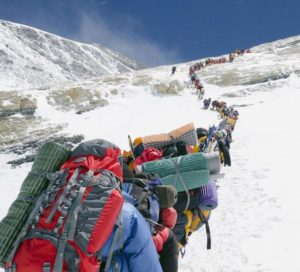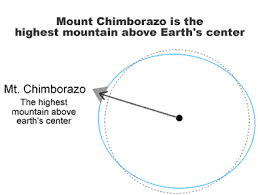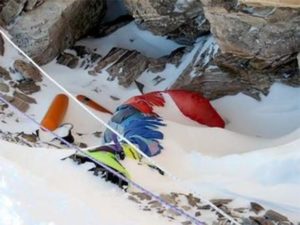Just Because It’s There, Doesn’t Mean I Have to Climb It: On Not Climbing Everest

They paid to do this. A mule train of mountaineers searching for their peak experience on Mount Everest.
Mount Everest is 29,000 ft. tall, but assaulting the summit actually begins at Base Camp which is at 18,000 feet. So in reality it’s an 11,000 ft. climb. But please, do not think I’m trying to diminish this redoubtable feat. Far from it. Successfully summiting Everest involves a mighty confluence of endurance, planning, money and oxygen. And let us not forget that even though Base Camp is at a lofty 18,000 ft., airplane oxygen masks drop down at 14,000 ft. – that is, “in the unlikely event of cabin depressurization.”
And not too diminish the majesty of Mount Everest; but due to a geologic quirk in the earth’s Jello-ey innards, Everest is not even the highest point on earth. That distinction belongs to Mount Chimborazo in Ecuador, sticking up at a pedestrian 20,703 ft. So even though Mount Everest has a higher cardinal altitude, Chimborazo has the distinction of being the “highest mountain or point above Earth’s center,” because Earth is not a sphere. It’s an oblate spheroid and bulges in certain areas (like most of us do) rendering Mount Chimborazo “closer” to outer space than Mount Everest.
Formidable, Demanding Everest
The air is thin up in the pristine yonder of Mount Everest. It can make your blood boil (like when you watch FOX News) and lead to altitude sickness and disorientation. The air is really thin, but then again, who wants fat air. The old saying “You can never be too thin or too rich” doesn’t apply to Everest’s air. It is too thin and needs to be more oxygen-rich. This is a hazard not readily apparent to the naked eye, but very apparent to the naked lung.
You can’t even boil an egg on Everest because, due to a decrease in atmospheric pressure as one ascends, the boiling point of water decreases to around 160°. Water will not get any hotter than that even though it’s boiling. At this temperature it will only slightly harden egg whites and leave the center a river of yolk. And while the ability to hard boil eggs on Everest may seem of trifling concern, it is indicative of the dangerous constellation of life-threatening parameters a diligent alpinist must overcome: thin air, low atmospheric pressure, intense UV radiation, and you can forget about finding a Starbucks past 22,000 ft.
The temperatures near the summit average -20° F. But this is balmy compared to the wind chill factor brought on by 100 mph gales where unrelenting wind wicks away heat at a hypothermically dangerous rate, rendering the effective temperature more like a Martian -70° F. Accordingly, Nepalese authorities have strongly discouraged ALS Ice Bucket Challenges above 25,000 ft.
The sun’s rays grow diabolically fierce as one ascends Everest. As you approach the top of the troposphere the ozone layer begins to thin (dare I say it: “Then again, who wants fat ozone?”). Precaution must be taken to protect your skin and eyes from this intense Ultra Violet shower. Without nature’s sun block (ozone) to shield you from Old Sol’s harmful UV radiation, a trek on Everest is like climbing a mountain while inside a tanning booth. Without SPF protection, an hour on sun-drenched Everest is like a week on Mercury. Accordingly, Board Certified dermatologists recommend using an SPF of 4000 to keep your skin safe.
An SPF of 4000? – whoa. What the hell. I’m losing it here. I’m somewhat confused or bewildered. Maybe even nonplussed. The point is I think I’m experiencing a “contact altitude sickness” and am developing a kind of sympathetic response to the disoriented mountaineers I’m writing about. Must get self out of story…this “contact altitude sickness” act is wearing thin…then again who wants a fat altitude sickness act? OK. Breathe. Slowly. Alright. Good rhythm. Baby I’m back and ready to do some more mansplainin’.
But More to the Point
Climbing Mount Everest is not some one-off, virtuoso event completed with dispatch and swagger. It’s a slow, methodical procedure ill-suited to an adrenalized rock-jock looking to put a notch in his crampon. Fortunately it’s evolved into more of a routinized, supervised, time-slotted trek superintended by the Nepalese government. The climbing season typically lasts from May until early September when poor weather and shorter days preclude safe climbing. The government lays out a roped course in the preseason based on last year’s snows. Each climber must pay a permit fee of $11.5K just for the privilege of overcoming the aforementioned hazards to climb Mount Everest. They must also contract with a Sherpa guide for around $4000 (they are tipped more if they reach the summit). A Sherpa is usually a leather-faced local, inured to the physical privations of alpinism and burdened with carrying the supplies of their dilettante tenderfoots. You’re not even allowed above Base Camp without these prerequisites.
In this way you don’t get gonzo Chuck Norris types flying to Nepal in a parka and Timberlines to go it alone in a hubristic act of self-reliant suicide. Nepal has put the kibosh on unhinged thrill seekers – too many deaths, too much bad publicity. Not that it’s a tame experience by any means. It has, however, evolved into a routinized event, fraught with danger that increases exponentially above 26,000 ft. – an area known as the Death Zone. This is where the majority of the 200+ climbers have died on Everest owing primarily to the consequences of oxygen-depleted air.
At this altitude the body processes only 30% of the oxygen it does at sea level. A person brought to this altitude directly from sea level would be unconscious in minutes. That is why Sherpas must carry several specialty oxygen canisters made only in Russia (weighing about 6.5 lbs. and costing around $1000) for their unacclimated bwanas. In the absence of supplemental oxygen a climber’s brain may swell (a condition known as edema) causing disorientation and poor decision-making – not exactly the faculties you can afford to lose when negotiating an icy crevasse at 5 miles above sea level. That a few hearty souls have summited Mount Everest without supplemental oxygen is testament to their applicative vigor and questionable sanity.
Much to the chagrin of inexperienced millennials who depend on technology to facilitate their every move, the Uber app will not work above Base Camp – or even below Base Camp or anywhere else in the rickshaw-clogged streets of Nepal. Oh sure you’ll see those tiny little monopoly cars moving around your iPhone screen like centipedes as they tempt you with their phantom proximity, but they’ll never arrive to pick you up because they’re not really there. C’mon now. Think man! There aren’t any roads up there.; so how can there be cars?
They Said It Couldn’t Be Done
It is estimated about 200 red-blooded mountaineers have reached the summit without the use of supplemental oxygen – very red-blooded mountaineers. This feat was thought physically impossible until Americans Rheinhold Messner and Peter Habeler achieved it in 1978 Climbing Everest w/o Oxygen. From National Geographic:
During their second attempt, Messner and Habeler succeeded—barely. On their final day of climbing, they resorted to hand signals to communicate, so as not to waste any precious breath. They fell to their knees and lay in the snow like beaten dogs in an effort to catch their breaths. Habeler began hallucinating. Messner experienced a sensation of “bursting apart.” He later said that his mind was fully dead and only his soul was pushing him upward. With less than 80 vertical meters left to climb, they collapsed every ten feet and literally crawled to the highest point on Earth.
Later, writing about that moment of reaching Everest’s summit, Messner gave the world this gift of poetry: “In my state of spiritual abstraction, I no longer belong to myself and to my eyesight. I am nothing more than a single narrow gasping lung, floating over the mists and summits.”
Brass Tacks
A properly outfitted climb will cost from $40,000 to $100,000. Expenses add up quickly: airfare, permits, Sherpas, equipment, Brylcreem. And no expense can be spared in the wind-chill swept hardscape of unforgiving alpine operations. For example a pair of Sherpa-quality Black Diamond gloves can set you back $250 – and you’ll need 2 pair. An Arc’Teryx hard shell jacket comes in at the princely sum of $600 and that includes the 2 desiccant packets thoughtfully placed in each pocket. Clearly this pursuit is not for the faint of wallet. That’s why I’d choose climbing Mt. Chimborazo in Ecuador. It’s simultaneously 9000 feet lower (in absolute measurement from sea level) and yet remarkably 8000 feet higher (as measured by from the center of the earth). I call it Mount Ambiguity – being both higher and lower simultaneously.
To date approximately 4000 humans (paying customers and Sherpas) have summited Mount Everest since New Zealander Sir Edmund Hillary and his famous Sherpa, Tenzing Norgay, first accomplished it in 1953. Climbing Everest was a moonshot back then. One can only imagine what Mission Control would’ve said had they been reporting on the feat: That’s many, many, many small steps for man. One giant leap for mankind.
At present, summiting Everest is less like a moonshot and more like a trip to the International Space Station. At minimum there are 2 requirements: money and the endurance of a spawning salmon. It is worth noting that a greater number of nameless and forgotten Sherpas have stood atop Mount Everest than so-called intrepid mountaineers ever have. Summiting is done mostly from the Nepalese south side as opposed to the more arduous Tibetan (Chinese) north side. Permits cost about $11.5K in Nepal and $9500 in China. These rates are reduced during the less hospitable off-seasons. As of yet no Groupons are available.
Despite these virtually insurmountable obstacles and the taxing maneuvers required to overcome them, hundreds of ardent souls sign up for this Bataan Death March every season. I’ll grant you mountaineers have a different perspective on the event than I. They view it more as a bucket list challenge of Man vs. Nature – a test of wills. An event where perseverance and a highly defined goal make climbing Everest more a sacred mission and less a death march.
This cautionary essay highlighting a litany of hazards associated with climbing Mount Everest has sworn me off the mountain for all-time and only reinforces my decision to non-climb it. Not that I seriously entertained climbing it in any real sense – after all, I like my eggs hard-boiled. I do however salute those who endeavor to go where no sane man should ever bother going. These altitudinous warriors are true to themselves in answering a call from on high. As for me, this call will always go straight to voicemail.
The End
***Notes, Anecdotes and Tall Mount Everest Tales***
How Mount Everest Got Its Name: The Fake Version and the Real Version
Fake: Back when the sun never set on the British Empire, a survey was taken of what was thought to be the world’s tallest mountain. When the Queen’s surveyor Col. Brigadoon Muttonchop first espied the mountain he remarked in reserved astonishment, “I do say dear boy, that mountain just seems to go on forever.”
To which Muttonchop‘s drunken assistant replied, “Quite agreed colonel, it does go on forever – it’s the ever-est mountain ever.
Real: Mount Everest was named after British surveyor George Everest in 1856. Despite the mountain already being called Chomolungma by the Tibetans and Sagarmatha by the Nepalese, the British decided to name it after Colonel George Everest, head of the survey. Sounds like a Mount McKinley, Mount Denali situation. We Westerners will co-opt and rebrand anything we can stick a flag on.
A Novice Climber’s Checklist for Conquering Mount Everest:
- Food: 2 big Turkey Clubs. 1 for Base Camp and one for when I get near the top, which they call the “summit.”
- Altitude Training: Sleep in the attic for a week where the air is thinner. This should prep me for higher altitudes and prevent what they call “altitude sickness.” This will also help me overcome my fear of silverfish.
- Equipment: Swedish Army Knife (Swiss Army Knife too expensive)
- Supplies: Bring the “good” windbreaker mom got me for Xmas. The one where you can cinch the sleeves.
- Sherpas: Choose only stout, rugged men familiar with at least 2 songs from The Sound of Music.
- Plenty of toothpaste (can also be used as sunblock)
- Moustache comb, hard boiled eggs.
- A pee funnel to prevent frostbite
- A pee funnel warmer to prevent sticking
- Catheter: This way I won’t need the stupid pee funnel
- My good, bumpy sneakers for better gripping on glare ice.
- Ray Bans, Fidget Spinner and the new John Grisham novel.
Game on!
Another Perspective on Our Pale Blue Marble
According to a Discover Magazine Blog from 2008 Discover’s Billiard Ball Example, if you scaled the earth down to the size of a billiard ball it would actually be smoother. Although it would probably be unsuitable for shooting pool.
Climbers from 19 to 80
The youngest person to reach the summit is 19-year-old Alyssa Azar of Austrailia who accomplished the feat in 2016. The oldest is 80-year-old Japanese climber Yuichiro Miura who broke the record of 76-year-old Min Bahadur Sherchan in 2013. Min Bahadur Sherchan attempted to reclaim the title at age 85 but died of a heart attack at Base Camp in May of 2017.
An Ultra-Mini-Treatise on Reality
This altitudinal peculiarity of Mount Chimborazo viz. Mount Everest is one of those bizarre earthly counterpoints that leaves one never knowing what they can believe in: How can Mount Everest not be the highest point on earth. Again, this is due to (and I believe the following phrase is the precise scientific term) Jello-ey Bulging Forces at the equator that jut Mount Chimborazo farther out into outer space than Mount Everest. In essence, Mount Chimborazo is farther from the Middle of the Earth than Mount Everest. Our supposed reality is so damn malleable, sometimes it’s difficult to know where the truth lies (interesting turn of phrase: the truth lies).
Disclaimer: By this Middle Earth standard (a Tolkien standard?), Mount Chimborazo is about 8,000 ft. higher than Mount Everest. Now I’m no reactionary and I certainly wouldn’t say it’s “Fake News” to proclaim Mount Everest as the highest mountain. I just think it’s important to consider other perspectives*.
*This disclaimer is brought to you by the Society for Promoting Mount Chimborazo as the Tallest Mountain in the World. Readers will note that I was paid a small fee (3 Chicken Chimborazos) to promote this as an “Alternative Fact.”
We operate within these fleshy bodies while tramping about on the 3rd rock from the sun in a kind of livable, breathable biosphere. Thankfully God has poked some holes in our cozy habitat so we don’t all suffocate. And here we reside thinking we’re all that; and yet we’re hanging in space by a thread totally dependent for all our light, energy and food from our “white dwarf” star – the sun. Fortunately our white dwarf deliverer from darkness is involved in a healthy and stable thermonuclear fusion relationship allowing for relatively uniform amounts of light and heat to sustain us as it slowly converts all its hydrogen to helium.
If you really want to worry about something, think what might happen if we pissed off the Sun and it decided to retaliate. Maybe we should stop referring to our diminutive sustainer of life as something other than a “White Dwarf” Star and begin calling it the more Astronomically Correct term: an “Ethnically Neutral Little Person Star.”
The Final End: You’ve reached the summit and now have nowhere to go but down. Thank you for your time and don’t forget to tip your Sherpas.



